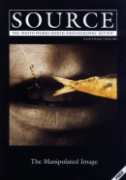Interface Images
Peacelines: Photographs by Frankie Quinn - Old Museum Arts Centre, January, 1995.
Review by Nicholas Allen
Issue 3 Winter 1994
View Contents ▸
The children struck me the most - even the ones with cider and moustaches, either glaring sullenly at the intrusion or beating carelessly as they hang upside down from iron railings. The black and white captures them perfectly in a clarity which so unfairly captures their moment; unfairly because the static places them in landscapes of weeds, of thick splashed slogans on walls, against the grids around them. The faces may laugh or stare but remain the same, caught as images in a study highlighting division. The grim final picture of another brick being planted seems too tacit an acceptance of our future, too lacking a dynamic much better caught in the kids blasting footballs in Cliftonville. The still life has always been a problem in Northern Ireland...
Throughout, faces peer out from broken glass and around brick terraces, as filled in windows give no light. Through it all, and some of these pictures, rides a nostalgia, as an aged woman looks on as the machine destroys another row and the man pushes his empty pram beside a park of spikes and bars. To me this theme is in turn related to the images of people in transit throughout the book, walking dogs and themselves in areas so defined that Escher's prints of endlessly circling monks seem liberating. From Peacelines by Frankie Quinn.
From Peacelines by Frankie Quinn.
Hence the paradox- the motion suggests life stirring beyond those walls, but the damned walls encircle all (one point of the book?). Their domination and symbolism go unanswered as the only implied solutions are retreats into dreamtime or the next planted brick. All this denies the future and traps the people caught in the lens. It is not by the pap of "Hey mister, can we have our ball back?" (with all its resonances of subjugated but spirited youth) but by the transcendence suggested by the beautiful photograph from New Barnsley, that we may proceed. Such half-admitted promises of liberation are not allowed to breed in this work and this is disappointing; disappointing because the 'peacelines' suggest nightmare but rarely does the partial eye of the photographer suggest struggle beyond the beaten steel. After all, our community may not find succour in the common dearth of economic and cultural opportunity, but in the gaps between what all have experienced. Or so it seems to me.
And so on to religion. The pictures capture well the lack of it. 'Kill all Taigs', caught grossly on a wall, would sit well beside any Fatwah, all the more remarkable due to its breadth of scope. The monochrome hits well as 'Blessed are those who hunger for justice' looks about to flake off the wall, as if its implications were too strenuous to justify a new lick of gable-end paint.
After all these thoughts I write only from care and despair. Like the boy pictured off Cupar Way on the Shankill I'm trying to look above the rising metal to the light which might be caught before it sets. Nice idea, that...
Other articles by Nicholas Allen:
Issue 4: Reviewing My Insolent Ontologies - The Family Album [Review] ▸
Issue 13: Causality and Contingency - Irish Landscape Images [Review] ▸
Other articles mentioning Frankie Quinn:
Other articles on photography from the 'Documentary' category ▸






